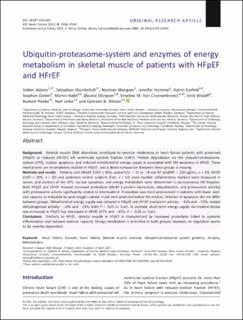| dc.contributor.author | Adams, Volker | |
| dc.contributor.author | Wunderlich, Sebastian | |
| dc.contributor.author | Mangner, Norman | |
| dc.contributor.author | Hommel, Jennifer | |
| dc.contributor.author | Esefeld, Katrin | |
| dc.contributor.author | Gielen, Stephan | |
| dc.contributor.author | Halle, Martin | |
| dc.contributor.author | Ellingsen, Øyvind | |
| dc.contributor.author | Van Craenenbroeck, Emeline M. | |
| dc.contributor.author | Wisløff, Ulrik | |
| dc.contributor.author | Pieske, Burkert | |
| dc.contributor.author | Linke, Axel | |
| dc.contributor.author | Winzer, Ephraim | |
| dc.date.accessioned | 2023-01-12T10:09:54Z | |
| dc.date.available | 2023-01-12T10:09:54Z | |
| dc.date.created | 2021-12-02T14:24:40Z | |
| dc.date.issued | 2021 | |
| dc.identifier.citation | ESC Heart Failure. 2021, 8 (4), 2556-2568. | en_US |
| dc.identifier.issn | 2055-5822 | |
| dc.identifier.uri | https://hdl.handle.net/11250/3042941 | |
| dc.description.abstract | Background Skeletal muscle (SM) alterations contribute to exercise intolerance in heart failure patients with preserved (HFpEF) or reduced (HFrEF) left ventricular ejection fraction (LVEF). Protein degradation via the ubiquitin-proteasome-system (UPS), nuclear apoptosis, and reduced mitochondrial energy supply is associated with SM weakness in HFrEF. These mechanisms are incompletely studied in HFpEF, and a direct comparison between these groups is missing. Methods and results Patients with HFpEF (LVEF ≥ 50%, septal E/e′ > 15 or >8 and NT-proBNP > 220 pg/mL, n = 20), HFrEF (LVEF ≤ 35%, n = 20) and sedentary control subjects (Con, n = 12) were studied. Inflammatory markers were measured in serum, and markers of the UPS, nuclear apoptosis, and energy metabolism were determined in percutaneous SM biopsies. Both HFpEF and HFrEF showed increased proteolysis (MuRF-1 protein expression, ubiquitination, and proteasome activity) with proteasome activity significantly related to interleukin-6. Proteolysis was more pronounced in patients with lower exercise capacity as indicated by peak oxygen uptake in per cent predicted below the median. Markers of apoptosis did not differ between groups. Mitochondrial energy supply was reduced in HFpEF and HFrEF (complex-I activity: −31% and −53%; malate dehydrogenase activity: −20% and −29%; both P < 0.05 vs. Con). In contrast, short-term energy supply via creatine kinase was increased in HFpEF but decreased in HFrEF (47% and −45%; P < 0.05 vs. Con). Conclusions Similarly to HFrEF, skeletal muscle in HFpEF is characterized by increased proteolysis linked to systemic inflammation and reduced exercise capacity. Energy metabolism is disturbed in both groups; however, its regulation seems to be severity-dependent. | en_US |
| dc.language.iso | eng | en_US |
| dc.publisher | Wiley | en_US |
| dc.rights | Navngivelse-Ikkekommersiell 4.0 Internasjonal | * |
| dc.rights.uri | http://creativecommons.org/licenses/by-nc/4.0/deed.no | * |
| dc.title | Ubiquitin-proteasome-system and enzymes of energy metabolism in skeletal muscle of patients with HFpEF and HFrEF | en_US |
| dc.title.alternative | Ubiquitin-proteasome-system and enzymes of energy metabolism in skeletal muscle of patients with HFpEF and HFrEF | en_US |
| dc.type | Peer reviewed | en_US |
| dc.type | Journal article | en_US |
| dc.description.version | publishedVersion | en_US |
| dc.source.pagenumber | 2556-2568 | en_US |
| dc.source.volume | 8 | en_US |
| dc.source.journal | ESC Heart Failure | en_US |
| dc.source.issue | 4 | en_US |
| dc.identifier.doi | 10.1002/ehf2.13405 | |
| dc.identifier.cristin | 1963516 | |
| cristin.ispublished | true | |
| cristin.fulltext | original | |
| cristin.qualitycode | 1 | |

